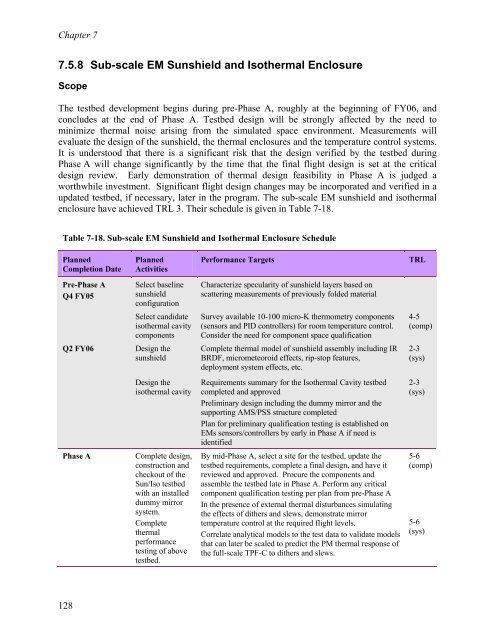TPF-C Technology Plan - Exoplanet Exploration Program - NASA
TPF-C Technology Plan - Exoplanet Exploration Program - NASA
TPF-C Technology Plan - Exoplanet Exploration Program - NASA
You also want an ePaper? Increase the reach of your titles
YUMPU automatically turns print PDFs into web optimized ePapers that Google loves.
Chapter 7<br />
7.5.8 Sub-scale EM Sunshield and Isothermal Enclosure<br />
Scope<br />
The testbed development begins during pre-Phase A, roughly at the beginning of FY06, and<br />
concludes at the end of Phase A. Testbed design will be strongly affected by the need to<br />
minimize thermal noise arising from the simulated space environment. Measurements will<br />
evaluate the design of the sunshield, the thermal enclosures and the temperature control systems.<br />
It is understood that there is a significant risk that the design verified by the testbed during<br />
Phase A will change significantly by the time that the final flight design is set at the critical<br />
design review. Early demonstration of thermal design feasibility in Phase A is judged a<br />
worthwhile investment. Significant flight design changes may be incorporated and verified in a<br />
updated testbed, if necessary, later in the program. The sub-scale EM sunshield and isothermal<br />
enclosure have achieved TRL 3. Their schedule is given in Table 7-18.<br />
Table 7-18. Sub-scale EM Sunshield and Isothermal Enclosure Schedule<br />
<strong>Plan</strong>ned<br />
Completion Date<br />
<strong>Plan</strong>ned<br />
Activities<br />
Performance Targets<br />
TRL<br />
Pre-Phase A<br />
Q4 FY05<br />
Select baseline<br />
sunshield<br />
configuration<br />
Characterize specularity of sunshield layers based on<br />
scattering measurements of previously folded material<br />
Select candidate<br />
isothermal cavity<br />
components<br />
Survey available 10-100 micro-K thermometry components<br />
(sensors and PID controllers) for room temperature control.<br />
Consider the need for component space qualification<br />
4-5<br />
(comp)<br />
Q2 FY06<br />
Design the<br />
sunshield<br />
Complete thermal model of sunshield assembly including IR<br />
BRDF, micrometeoroid effects, rip-stop features,<br />
deployment system effects, etc.<br />
2-3<br />
(sys)<br />
Design the<br />
isothermal cavity<br />
Requirements summary for the Isothermal Cavity testbed<br />
completed and approved<br />
Preliminary design including the dummy mirror and the<br />
supporting AMS/PSS structure completed<br />
<strong>Plan</strong> for preliminary qualification testing is established on<br />
EMs sensors/controllers by early in Phase A if need is<br />
identified<br />
2-3<br />
(sys)<br />
Phase A<br />
Complete design,<br />
construction and<br />
checkout of the<br />
Sun/Iso testbed<br />
with an installed<br />
dummy mirror<br />
system.<br />
Complete<br />
thermal<br />
performance<br />
testing of above<br />
testbed.<br />
By mid-Phase A, select a site for the testbed, update the<br />
testbed requirements, complete a final design, and have it<br />
reviewed and approved. Procure the components and<br />
assemble the testbed late in Phase A. Perform any critical<br />
component qualification testing per plan from pre-Phase A<br />
In the presence of external thermal disturbances simulating<br />
the effects of dithers and slews, demonstrate mirror<br />
temperature control at the required flight levels.<br />
Correlate analytical models to the test data to validate models<br />
that can later be scaled to predict the PM thermal response of<br />
the full-scale <strong>TPF</strong>-C to dithers and slews.<br />
5-6<br />
(comp)<br />
5-6<br />
(sys)<br />
128
















